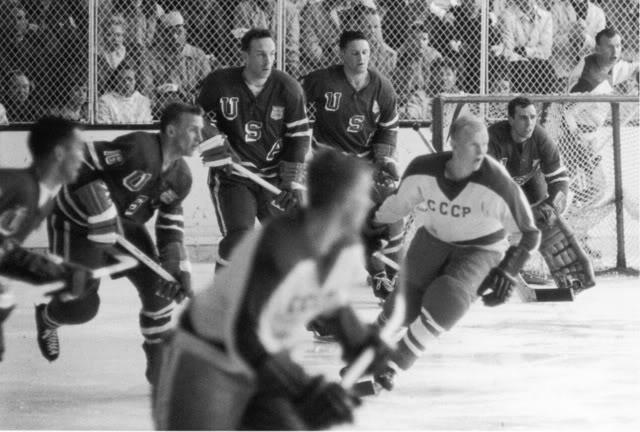Pre-Sports Diplomacy. Hockey broke the ice in the Cold War
In
Log in if you are already registered
Before the FIFA World Cup was given “sports diplomacy” status by pundits, academics and some among its own leadership, the ice hockey rivalry between the Soviet Union, the United States and Canada that developed during the 1960 Winter Olympic Games at Squaw Valley, California proved that competitive athletics could capture the hearts and minds of adversaries who were threatening each other with nuclear war.
Thanks to hockey, sports became a vehicle for the nuclear superpowers to project hegemony without casus belli before the concepts of public diplomacy and its adjunct sports diplomacy came on the scene during the early 1960s.
That’s the way it was when the Columbia Broadcasting System (CBS), controlled by William Paley, paid the paltry sum of $50,000 for the rights to televise the 1960 Winter Olympic Games in Squaw Valley, California.
Paley understood the relationship between propaganda and televised sports. During World War 2 he served as a Colonel in the Office of War Information (OWI), Washington’s domestic and international propaganda organization, which had a close relationship with the Office of Strategic Services (OSS), the forerunner of the modern Central Intelligence Agency. So did his employee, newsman Edward R. Murrow, considered by some public diplomacy poobahs operating in academia to be the godfather of public diplomacy.
Ironically, Elmer Davis, who had also worked for Paley at CBS, was named head of the OWI by president Franklin D. Roosevelt receiving a salary of $52,000 per year, more than what his ex-boss Paley would later pay for the rights to televise the 1960 Winter Olympic Games.
The OWI was also a magnet for future practitioners of cultural diplomacy. Notables who worked for the OWI included jazz music critic Ralph J. Gleason, who wrote for Down Beat, the ill-fated muckraker Ramparts, and was a co-founder of the influential counterculture publication Rolling Stone,which was financed in part by Intel founder Max Palevsky. Rolling Stone's music oriented audience provided the market base for the Apple Computer, and consumer PCs.
How hockey broke the ice
The CBS plan to acquire the rights to, and televise the 1960 Winter Olympics drew considerable opposition from inside the administration of U.S. president Dwight D. Eisenhower. The United States was still reeling from the witch hunts of the McCarthy Era. American film stars, directors, writers and some famous popular musicians who supported the U.S.- Soviet alliance during World War 2 and continued to support socialist causes were unable to work due to the blacklist.
Ice hockey wasn’t important in the minds of America’s “front line” of nuclear defenders, Edward Teller, Admiral Hyman Rickover, Air Force General Curtis LeMay and theorist Herman Kahn, whose nuclear politics made them the defenders of the realm. The straw that stirred the drink in this Yankee nuclear cocktail was professor Albert Wohlstetter, a political theorist at the University of Chicago whose contacts in Washington and elsewhere made him America’s leading behind the scenes national security guru and propaganda architect before Henry Kissinger came on the scene.
What the CBS ice hockey initiative did do was ignite an episode of classic Washington “brinkmanship.” The Eisenhower administration threatened to ban the Soviet Union and communist satellite nations from taking part in the Winter Olympics.
Controversial IOC Chairman Avery Brundage of the United States, who fought off charges of anti-Semitism as far back as the 1936 Berlin Summer Olympics, had a history of objecting to any commercial exploitation of the Olympc Games and payments of any kind to Olympic athletes. But he saw this form of commercialization as an opportunity for the future and mounted a counterattack. He threatened to resign if the Soviets and other Eastern European nations were excluded from the games.
The Eisenhower administration recanted and Paley’s $50,000 gamble that television viewers would be captivated by the competition between athletes from “capitalist” and “communist” nations would pay off.
The televising of the 1960 Squaw Valley Winter Olympics was a defining moment in the history of American and international broadcasting. It brought athletes from the Soviet Union and their emotions and passions as competitors into the homes of millions of Americans, and Canadians, who had been conditioned by mass media propaganda to believe that the communists were the enemy. Instead of threatening to kill Americans and Canadians with the hydrogen bomb, the bad guys, as the Canadians like to say were just trying to “put the biscuit in the basket.”
Just like in the United States, Soviet propaganda had created a similar political-psychological situation with the big winner being the defense industries of both nuclear superpowers. Neither hockey or sports diplomacy friendly FIFA football (soccer)or even soft power has changed that.

Credit: www.ironpigs.com
The Soviet Union walked away from the 1960 Squaw Valley Winter Olympics winning the most medals in the tournament. Although the USSR ice hockey team was defeated by the United States, who won the gold medal, the television viewer ratings for hockey were very strong, which created a foundation that guaranteed advertising support for future games.
The growing audience for Olympic ice hockey didn’t end the Cold War, nor did it overshadow the threats posed by of “massive retaliation” and “mutually assured destruction.” After all, the Cuban missile Crisis erupted two years later in 1962.
What it did do was provide evidence that Cold War rhetoric could be mediated, albeit temporarily, through the entertainment value provided to mass audiences by competitive athletics packaged as mega events.
Four years later, with the Cold War and the Vietnam War heating up, the “miracle of television” brought the 1964 Winter Olympics in Innsbruck, Austria into the homes of a billion television viewers worldwide.
American Broadcasting Company (ABC) alone paid $597,000 to acquire the rights to televise the Winter Olympics in the lucrative U.S. market, ten times what CBS paid to air the 1960 Squaw Valley games.
Over time, the value of the televising the Winter Olympics continued to increase exponentially. In 1989 CBS paid $300 million to acquire the rights to televise the 1994 Winter Olympics in Lillehammer, Norway.
Today, Russians, Czechs and Finns are stars in the National Hockey League (NHL). Vladislav Tretyak, one of the most admired hockey players in the history of the Soviet Union, was offered a contract by the Montreal Canadiens to play in the NHL during the Cold War but was unable to accept the deal. Today, he is a member of the Hockey Hall of Fame and has mentored some of the greatest goalkeepers in the history of the NHL.
Recently, the NHL joined a new sports diplomacy alliance developed by the U.S. State Department, which includes the National Football League (NFL), Major League Baseball (MLB), the National Basketball Association (NBA) to work on a micro, people to people level that still holds to the old Kennedy “New Frontier” concept of winning hearts and minds. Hockey distracted people from the nuclear component of the Cold War because it reminded fans that if you want to win, you don’t need to nuke the enemy, you just need to go out and hit somebody, like the late Canadian hockey fan and songwriter Warren Zevon sang in his famous song.




